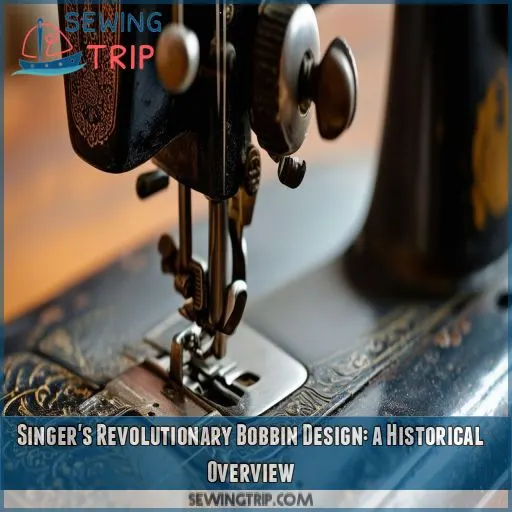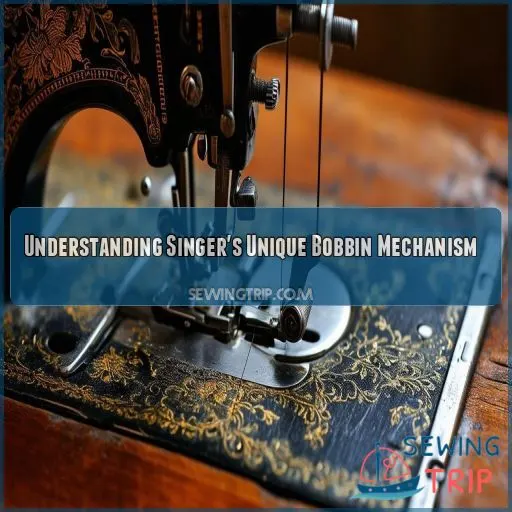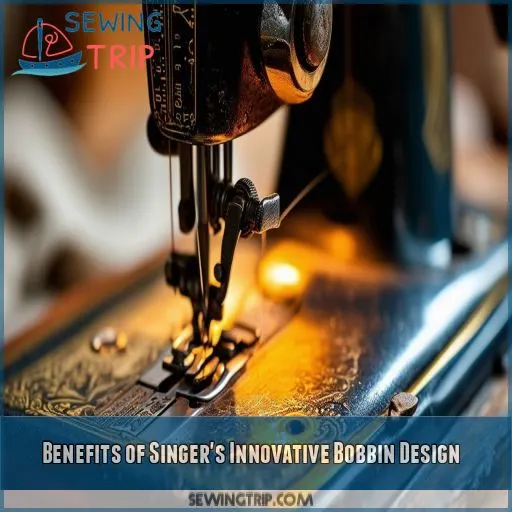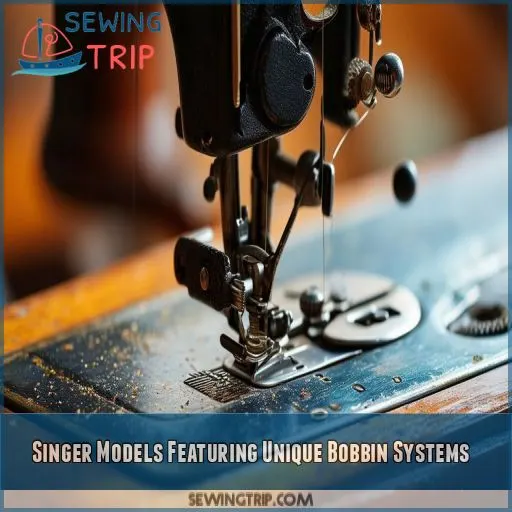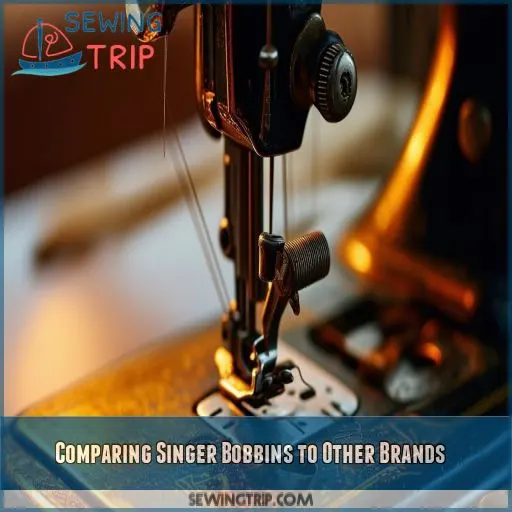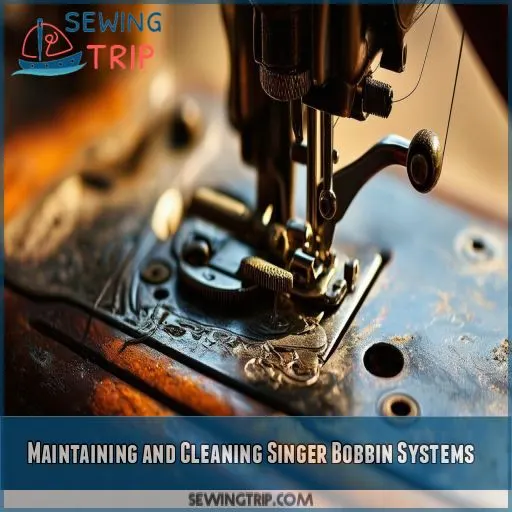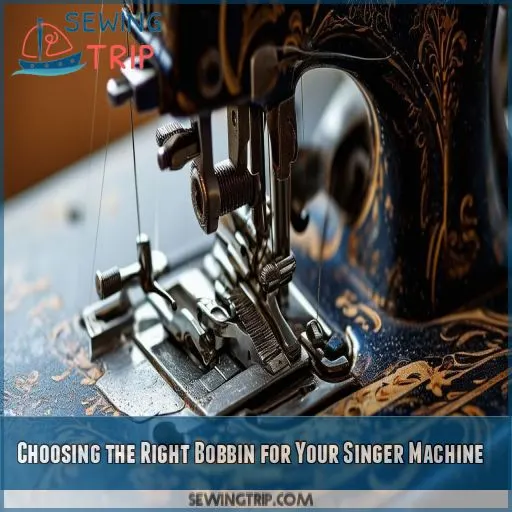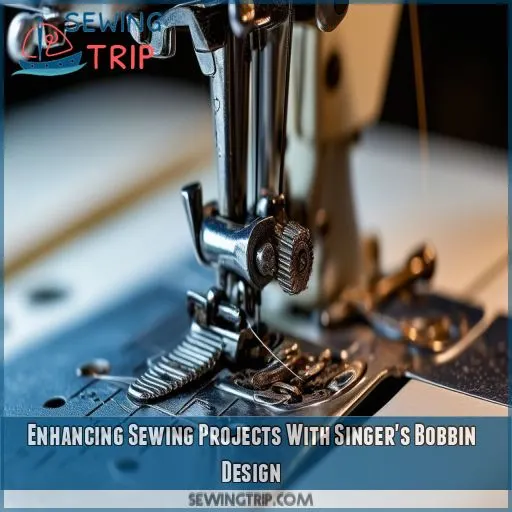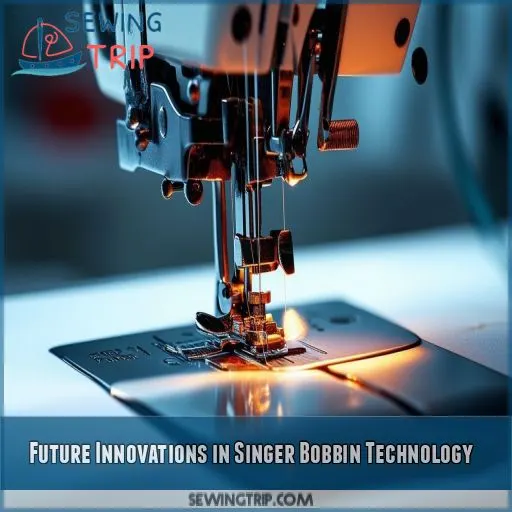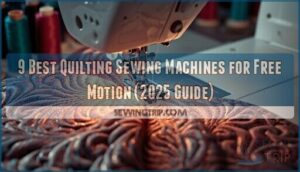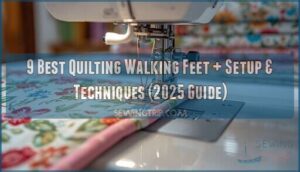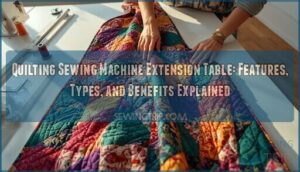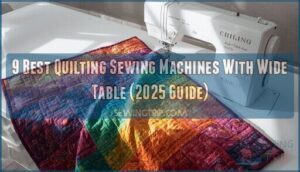This site is supported by our readers. We may earn a commission, at no cost to you, if you purchase through links.
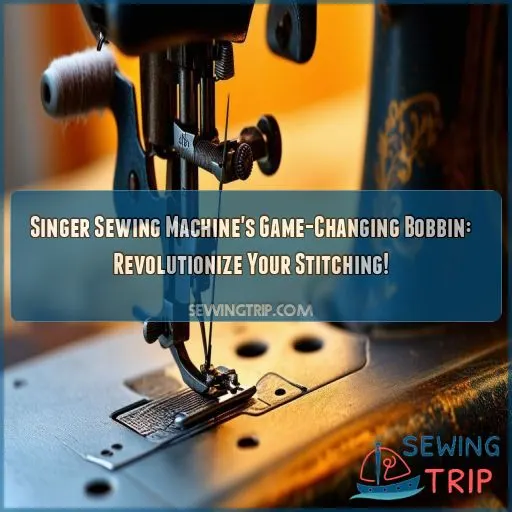
From the shuttle bobbin debut in 1851 to the drop-in bobbin in 1900, Singer has consistently improved stitch quality and accessibility.
These bobbins, found inside a case, are made of metal or plastic and come in various styles like front-loading and top-drop-in.
Stay tuned to learn more about Singer’s innovative bobbin journey and how it can enhance your sewing projects.
Table Of Contents
- Key Takeaways
- Singer’s Revolutionary Bobbin Design: a Historical Overview
- Understanding Singer’s Unique Bobbin Mechanism
- Benefits of Singer’s Innovative Bobbin Design
- Singer Models Featuring Unique Bobbin Systems
- Comparing Singer Bobbins to Other Brands
- Troubleshooting Common Issues With Singer Bobbins
- Maintaining and Cleaning Singer Bobbin Systems
- Choosing the Right Bobbin for Your Singer Machine
- Enhancing Sewing Projects With Singer’s Bobbin Design
- Future Innovations in Singer Bobbin Technology
- Frequently Asked Questions (FAQs)
- Conclusion
Key Takeaways
- Singer’s innovative bobbin designs, from shuttle bobbins to drop-in bobbins, have transformed the sewing experience, improving stitch quality and accessibility.
- The brand’s unique bobbin mechanism, with its metal or plastic bobbins and front-loading or top-drop-in styles, is the unsung hero, ensuring smooth stitching and enhanced performance.
- Singer sewing machines offer a range of benefits, including better thread tension control, reduced jamming, and easier maintenance, resulting in seamless sewing projects.
- With its history of revolutionizing the sewing machine industry, Singer continues to push boundaries, integrating smart technology and eco-friendly materials into its bobbin systems, shaping the future of sewing.
Singer’s Revolutionary Bobbin Design: a Historical Overview
You’re about to discover how Singer’s revolutionary bobbin design transformed the sewing world. From its humble beginnings to its industry-shaking impact, this game-changing innovation has been threading its way through sewing machine history for over a century.
The Birth of Singer’s Unique Bobbin
You’ve gotta hand it to Singer—they really hit the nail on the head with their unique bobbin design.
Back in the day, sewing was a real headache, but Singer’s innovation changed the game.
Imagine a world where thread tension was a constant battle.
Then boom! Singer’s bobbin swoops in like a knight in shining armor, revolutionizing stitch quality and ease of use.
It’s the unsung hero of sewing history!
Evolution of Singer Bobbin Systems
As Singer’s bobbin design evolved, you witnessed a sewing revolution unfold before your eyes. From the early days of the shuttle bobbin to the game-changing drop-in bobbin, Singer kept pushing the envelope. Here’s a quick rundown of the key milestones:
- 1851: Shuttle bobbin introduced
- 1879: Oscillating hook bobbin debuts
- 1900: Class 66 drop-in bobbin arrives
- 1950s: Rotary hook bobbin takes center stage
Each innovation brought smoother stitching and fewer headaches to your sewing adventures.
Impact on Sewing Machine Industry
You mightn’t realize it, but Singer’s revolutionary bobbin design shook up the entire sewing machine industry! Let’s take a quick peek at how this game-changer impacted sewing:
| Impact | Before Singer | After Singer |
|---|---|---|
| Speed | Slow and tedious | Lightning-fast |
| Consistency | Hit or miss | Smooth as butter |
| Accessibility | For pros only | Everyone’s cup of tea |
Talk about a stitch in time that saved nine… million headaches!
Understanding Singer’s Unique Bobbin Mechanism
Ever wondered what makes Singer’s bobbin mechanism so special? Let’s get into it! Imagine a tiny metal or plastic spool that’s the unsung hero of your sewing machine. Singer’s unique bobbin design is like a well-oiled machine within a machine. It’s got a nifty little case that cradles it just right, ensuring smooth operation.
You’ll find different types of bobbins in Singer’s lineup, from the classic front-loading style to the modern top-drop-in variety. Each one’s engineered to play nice with its specific machine model. The evolution of these little powerhouses has been nothing short of revolutionary in the sewing world.
Whether you’re working with a vintage Singer or a cutting-edge model, understanding this key component is vital to mastering your craft. So next time you’re threading your machine, give that bobbin a nod of appreciation!
Benefits of Singer’s Innovative Bobbin Design
Singer’s innovative bobbin design offers a range of benefits that’ll take your sewing to the next level. You’ll experience improved stitch quality, better thread tension control, fewer jams, and easier threading and maintenance, making your sewing projects smoother and more enjoyable than ever before.
Improved Stitch Quality
You’ll be amazed at how Singer’s innovative bobbin design takes your stitch quality to new heights.
Say goodbye to wonky seams and hello to picture-perfect stitches! This game-changer makes sure thread delivery is consistent, resulting in even, professional-looking rows.
Whether you’re whipping up a quick hem or tackling a complex quilt, you’ll notice the difference immediately.
It’s like having a tiny stitch perfectionist working tirelessly inside your machine!
Enhanced Thread Tension Control
Ever felt like you’re wrestling with your sewing machine’s thread tension?
Singer’s innovative bobbin design puts you in the driver’s seat. You’ll have precise control over thread tension, ensuring your stitches are always on point.
No more guesswork or frustration! This game-changing feature lets you tackle delicate fabrics with confidence and achieve professional-quality results.
It’s like having a seasoned tailor at your fingertips, guiding every stitch to perfection.
Reduced Jamming and Tangling
You’ll love how Singer’s innovative bobbin design tackles the age-old nemesis of sewing: jamming and tangling.
Say goodbye to those frustrating moments when your thread turns into a bird’s nest!
The precision-engineered bobbin system keeps your thread flowing smoothly, like a well-choreographed dance.
No more wrestling with knotted messes or pausing every few stitches to untangle your work.
It’s like having a personal anti-tangle guardian for your sewing projects!
Easier Threading and Maintenance
- Snap-in bobbin case for quick changes
- Clear view bobbin cover to monitor thread supply
- Self-threading bobbin case – no more squinting!
- Easy-to-clean bobbin area for hassle-free maintenance
Say goodbye to tangled threads and hello to smooth sailing in your sewing adventures!
Singer Models Featuring Unique Bobbin Systems
You’ll find Singer’s innovative bobbin design in several iconic models that have revolutionized sewing over the years. From the classic Class 66 machines to the beloved Featherweight series and modern models with advanced bobbin systems, Singer has consistently pushed the boundaries of what’s possible in home sewing.
Singer Class 66 Machines
You’ll love the Singer Class 66 machines, the true game-changers in sewing history! These beauties introduced the revolutionary "drop-in" bobbin system in 1900, making threading a breeze. With their unique design and serial numbers starting with "G," Class 66 models quickly became the gold standard for home sewing. They’re not just machines; they’re a piece of Singer history that’ll make your stitching sing!
Singer Featherweight Series
Moving on from the Class 66, let’s check out the beloved Singer Featherweight series.
You’ll fall head over heels for these compact powerhouses!
Introduced in 1933, the Featherweight 221 became an instant hit with its innovative bobbin system.
This little marvel packed a punch, combining portability with precision stitching.
Its unique bobbin design made for smooth operation, making it a favorite among quilters and sewists alike.
Modern Singer Models With Advanced Bobbins
Moving from the iconic Featherweight, modern Singer models have taken bobbin technology to new heights. You’ll find advanced features that’ll make your sewing projects a breeze:
- Top-loading, jam-proof bobbin systems
- Clear bobbin covers for easy thread monitoring
- Automatic bobbin winders with thread cutters
These innovations aren’t just bells and whistles—they’re game-changers that’ll help you stitch like a pro. Say goodbye to bobbin blues and hello to smooth sailing!
Comparing Singer Bobbins to Other Brands
You might think all bobbins are created equal, but Singer’s unique designs set them apart from the competition. Let’s explore how Singer bobbins differ from other brands in size, shape, materials, and compatibility, and why these differences matter for your sewing projects.
Differences in Size and Shape
Let’s get into the details of Singer bobbins compared to other brands.
You’ll notice that Singer’s unique design often sets them apart. They’re like the fingerprints of the sewing world – no two brands are quite the same!
While Singer bobbins tend to be more compact, other brands might be larger or have different shapes.
This can affect how they fit and perform in your machine.
Material Composition
Singer bobbins stand out from the rest in terms of material composition.
While many brands opt for plastic, Singer often uses metal for durability.
Metal bobbins can handle high-speed stitching without breaking a sweat, making them perfect for heavy-duty projects.
But don’t write off plastic entirely—it’s lightweight and budget-friendly for everyday sewing tasks.
Compatibility With Non-Singer Machines
You might be wondering, "Can I use Singer bobbins in my non-Singer machine?" Well, it’s not always a perfect match, but there are ways to make it work. Here’s what you need to know:
- Some non-Singer machines can use Singer bobbins with a universal adapter
- Cross-brand compatibility often depends on the specific model and bobbin type
- Certain Singer bobbins are designed to be more universal than others
- Always check your machine’s manual before attempting to use non-native bobbins
Troubleshooting Common Issues With Singer Bobbins
You’ve got your Singer sewing machine with its innovative bobbin system, but sometimes things don’t go as smoothly as you’d like. Let’s tackle common Singer bobbin issues head-on, from pesky thread tension problems to bobbin case alignment woes, and even those mysterious noises and vibrations that can throw a wrench in your sewing projects.
Thread Tension Problems
| Problem | Cause | Solution |
|---|---|---|
| Loose top stitches | Insufficient top tension | Increase top tension dial |
| Puckered fabric | Excessive top tension | Decrease top tension dial |
| Looping on underside | Insufficient bobbin tension | Tighten bobbin case screw |
| Skipped stitches | Incorrect threading | Rethread machine, check needle |
Bobbin Case Alignment
Once you’ve tackled thread tension, let’s move on to bobbin case alignment.
This really important element can make or break your sewing experience.
If your stitches look like they’re doing the cha-cha instead of a straight line, your bobbin case might be out of whack.
Don’t fret! With a few tweaks, you’ll have your Singer purring like a kitten in no time.
Addressing Noise and Vibration
Don’t let a noisy bobbin drive you up the wall!
First, check if your bobbin’s seated correctly – a loose fit can cause quite the commotion.
Next, give your machine a good oiling, focusing on the bobbin area.
If the racket persists, inspect for worn parts.
Time to silence that sewing symphony!
Maintaining and Cleaning Singer Bobbin Systems
You’ll be amazed at how a little TLC can keep your Singer bobbin system purring like a well-oiled machine. Let’s explore the essential maintenance routines that’ll have your sewing projects running smoother than a hot knife through butter, from regular cleaning to proper lubrication and timely part replacements.
Regular Cleaning Procedures
Now that we’ve tackled those pesky bobbin issues, let’s get into keeping your Singer’s bobbin system spick and span. Regular cleaning isn’t just about aesthetics; it’s the secret sauce to a smoothly running machine. Here’s why you’ll love giving your bobbin some TLC:
- Boost your sewing mojo with a lint-free bobbin area
- Say goodbye to tension troubles caused by hidden debris
- Extend your machine’s lifespan, one cleaning session at a time
Lubrication Techniques
Now that you’ve mastered cleaning, let’s move on to the art of lubrication.
It’s like giving your Singer’s bobbin a spa day! Grab your trusty sewing machine oil and manual – they’re your best friends here.
A well-oiled bobbin is the secret sauce to smooth stitching.
Don’t go overboard, though; a little dab’ll do ya.
Stick to a regular oiling routine, and your Singer will purr like a kitten!
Replacing Worn Bobbin Parts
Don’t let worn bobbin parts put a wrench in your sewing plans! Over time, these tiny workhorses can show signs of wear. But fear not, replacing them is easier than threading a needle in the dark. Here’s your game plan:
- Inspect your bobbin case for scratches or burrs
- Check the bobbin tension spring for weakness
- Look for worn spots on the bobbin itself
- Consider upgrading to a smoother, more durable bobbin material
Choosing the Right Bobbin for Your Singer Machine
You’re about to dive into a world that’ll transform your sewing game. Get ready to unravel the mysteries of Singer’s unique bobbin system and discover how choosing the right bobbin can make all the difference in your stitching adventures.
Identifying Compatible Bobbin Types
Now that you’ve got your Singer bobbin system spick and span,
let’s tackle the puzzle of finding the perfect bobbin match. It’s like dating for your sewing machine!
You’ll want to check your Singer’s model number and consult the manual – it’s your matchmaking guide.
Don’t worry if you’ve lost it; Singer’s website is a treasure trove of compatibility info.
Plastic Vs. Metal Bobbins
Choosing between plastic and metal bobbins for your Singer sewing machine can feel like a tangled mess!
Metal bobbins are known for their durability and consistent tension.
Plastic bobbins, on the other hand, are easier on your wallet and your machine.
But don’t let the size fool you – both types can handle the job.
Ultimately, your choice depends on your sewing style and how your machine uses bobbins.
Pre-wound Vs. Self-wound Bobbins
When you’re thinking about bobbins, you’ve got two options:
Pre-wound bobbins are like a sewing shortcut – they’re ready to go, saving you time and hassle.
But hold your horses! Self-wound bobbins give you more control over thread choice and tension.
It’s like choosing between a pre-made meal or cooking from scratch.
Which one suits your sewing style?
Let’s unravel this thread together!
Enhancing Sewing Projects With Singer’s Bobbin Design
Singer’s unique bobbin design isn’t just a technical marvel—it’s your secret weapon for taking your sewing projects to the next level. With improved stitch quality and better control over challenging fabrics, you’ll find yourself tackling ambitious projects with newfound confidence and achieving professional-looking results that’ll make your sewing buddies green with envy.
Achieving Consistent Stitch Quality
Now that you’ve chosen the perfect bobbin, let’s get into achieving stitch consistency that’ll make your projects shine.
With Singer’s innovative bobbin design, you’re in the driver’s seat of stitch quality.
Say goodbye to wonky seams and hello to precision!
By mastering bobbin tension and following your sewing machine guide, you’ll be cranking out professional-looking stitches in no time.
It’s like having a personal stitch whisperer at your fingertips!
Tackling Challenging Fabrics
Ready to tackle those tricky fabrics?
Singer’s game-changing bobbin‘s got your back! From slippery silks to hefty denims, you’ll breeze through projects with ease.
Adjust your tension like a pro, and watch those pesky puckers disappear.
Don’t forget to match your needle to your fabric weight – it’s a game-changer!
With Singer’s expertise, you’ll be the master of every material in no time.
Specialized Techniques for Unique Bobbins
Now that you’ve mastered challenging fabrics, let’s take a closer look at specialized techniques for Singer’s unique bobbins. These game-changers aren’t just for everyday sewing; they’re your secret weapon for next-level projects. Here’s how to harness their full potential:
- Bobbin play: Create texture by intentionally adjusting tension
- Decorative underside: Use contrasting thread for hidden designs
- Bobbin work embroidery: Draw with the bobbin thread
- Reverse appliqué: Utilize bobbin thread for peek-a-boo patterns
Future Innovations in Singer Bobbin Technology
Get ready for the next generation of Singer bobbins that’ll transform your sewing experience. You’ll soon be using smart bobbin systems that integrate with digital platforms, while eco-friendly materials make your stitching more sustainable than ever before.
Smart Bobbin Systems
You’ve mastered Singer’s unique bobbin design, but get ready for the next big leap: smart bobbin systems! These high-tech marvels will revolutionize your sewing experience. Imagine a bobbin that communicates with your machine, adjusting tension on the fly and warning you when thread’s running low. Let’s peek at what’s coming:
| Feature | Benefit | Wow Factor |
|---|---|---|
| Auto-tension | Perfect stitches | No more guesswork |
| Thread level sensor | Never run out mid-seam | Stress-free sewing |
| Self-cleaning | Reduced jamming | More time creating |
| Digital display | Real-time data | Feel like a pro |
| Wireless connectivity | Sync with apps | Join the IoT revolution |
Eco-friendly Bobbin Materials
The future of Singer’s bobbin technology also includes eco-friendly materials. Sustainability is a key focus, with an emphasis on recycled, biodegradable, and compostable components. Singer 301 enthusiasts and sewing machine collectors alike are excited about these innovative bobbin materials, which are expected to revolutionize the sewing machine market and manufacturing processes.
Integration With Digital Sewing Platforms
The future of Singer’s bobbin technology is bright.
With potential integration into digital sewing platforms, imagine a seamless connection between your Singer sewing machine and online communities.
This connection could open up a world of interactive tutorials, pattern downloads, and real-time troubleshooting.
This digital integration could revolutionize how we learn new techniques, connect with fellow crafters, and access the latest trends in the sewing world.
Frequently Asked Questions (FAQs)
What is the most sought after Singer sewing machine?
The Singer 66 is the most sought-after machine, with its ‘red eye’ decals and classic design. The treadle version is the most expensive, retailing at £ Other models can be sourced for around £
Do all Singer sewing machines use the same bobbin case?
No, not all Singer sewing machines use the same bobbin case. Different models require different bobbin sizes and styles. Even within the same model, some machines use plastic bobbins, while others use metal.
What is the difference between Singer 4411 and 5511?
The Singer 4411 and 5511 are nearly identical, but the 4411 is gray and labelled ‘heavy duty‘, while the 5511 is white. The 4411 is also more widely available.
What is the difference between Singer Heavy Duty 4423 and 4411?
The Singer Heavy Duty 4423 has a built-in needle threader and 23 stitches, while the 4411 has 11 stitches and no automatic threader. Both are heavy-duty machines with powerful motors. The 4423 is slightly heavier.
What are the pros and cons of Singers bobbin design?
Singer’s bobbin design has its pros and cons. The top-loading design makes it easy to install and monitor thread levels. However, some older models require specific bobbins, and non-branded bobbins can damage your machine.
How does Singers bobbin system compare to other brands?
Singer’s bobbin system is designed to work specifically with its sewing machines. Using non-Singer bobbins can damage your machine. Other brands’ bobbins may differ in size, tension, and shape, affecting compatibility. Singer’s Class 15 and Class 66 bobbins vary in height and shape.
Can I use any type of bobbin in my Singer machine?
You should only use the bobbin type specified for your Singer model. Using the wrong bobbin can damage your machine. Singer bobbins are easy to buy and make sure your projects turn out great.
What issues might I face with Singers bobbin design?
What could possibly go wrong?" you ask, eyeing your sewing machine’s bobbin. Well, my friend, get ready for a tangled mess if you don’t watch out for these common issues with bobbin designs.
How do I clean and maintain my Singer bobbin system?
To clean and maintain your Singer bobbin system, regularly remove the bobbin and case, brush and wipe the area, and oil if needed. Check your manual for specific details and precautions.
Conclusion
It’s a wrap!
Singer’s unique bobbin design has been a game-changer since 1851, and its impact on the sewing world is undeniable.
You now know how Singer’s innovative bobbin journey, from shuttle bobbins to drop-in bobbins, has transformed stitching.
With improved stitch quality, easier threading, and reduced jamming, Singer sewing machines and their one-of-a-kind bobbins have empowered creators like you to take on any project with confidence.

